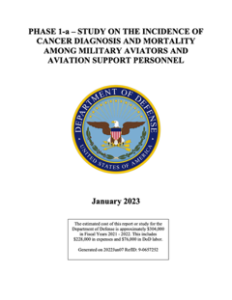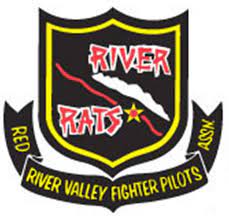Testimony of Pilot #37
On October 15, 2021 Commander Thomas ‘Boot’ Hill, Navy F-4 and F-14 fighter pilot, passed away from esophageal cancer. A-6 pilot Capt. Dave ‘Snako’ Kelly died from melanoma of the brain on 16 March 2014. Randy Anderson, Navy F-8, F-4, and Air Guard F-105 pilot died from Glioblastoma – brain cancer – 0n 4 Dec 2007.
Randy was my best friend out of college and roommate for the first half of flight school, until he got married and we went off to two different air stations for advanced flight training. ‘Snako’ and I were in the same airwing in Airwing Five on USS Midway for Linebacker I & II, he in Intruders and me in Corsairs – participants in many of the same Alpha Strikes into North Vietnam. Snako’s writing from his book Not on My Watch is an integral part of rememberedsky. I didn’t know CDR Hill, but after he was diagnosed with cancer, and began studying the connections of aviation and cancer focusing initially on Naval aviators, he eventually became involved with the Red River Valley Fighter Pilots Association (RRVA) and its Aviator Medical Issues Committee (AMIC). There he worked closely with a longtime friend and supporter of this website, retired F-15 pilot, Air Force Col Vince ‘Aztec’ Alcazar. Aztec is now the lead for AMIC.
Within a few years of his retirement Aztec was hearing about cancer among former squadron mates with death in 2-3 years. Continuing on over the years both Hill, Alcazar, and others noted a distressing trend: fellow aviators contacting cancer at unusually high rates, many dying. In 2019, an investigative series found clusters of cancer tied to Navy and Air Force aviation bases. The articles brought the issues out of the shadows, but advocates lacked the data or medical expertise to be taken seriously by the research community. Unfortunately, medical professionals gave them the stiff arm – “None of you are medical professionals, … you’re essentially a child running with scissors!”
But the issue caught the interest of then Air Force Chief of Staff Gen David Goldfein and the AF Surgeon General, Lt. Gen. Dorothy Hogg. After speaking with the RRVA (River Rats) they authorized an official Air Force study.
The USAF’s School of Aerospace Medicine under the Air Force Research Laboratory studied nearly 35,000 aviators and roughly 316,000 officers over the 34-year period of 1970 to 2004. This first ever study on the incidence of cancer among certain veteran aircrews was released In May 2021. The results were grim:
- Male fighter pilots were 29% more likely than other officers to be diagnosed with testicular cancer
- 24% more likely to get melanoma
- 23% more likely to have prostate cancer
- Airmen were also more likely to die from their cancers as compared to the general population as a result of melanoma, Non-Hodgkins lymphoma and prostate cancer.
So, where does this stand in 2024:
- For decades military flyers were labeled by military medicine as being among the healthiest members of the military; hence no need to study cancer in this group
- The contradiction: absence of evidence is not evidence of absence. Military aviators particularly those in the Air Force, Navy, and Marine Corps fighter/attack aircraft communities see and endure significant elevated cancer diagnosis & death rate(s)
- Veteran flyer cancers typically appear years after he/she left military aviation. This fits a clinical pattern known as the “cancer latency window”; here, Veterans exposed in service manifest their cancer 5-15 years after they left military service
- The results did get some notice and in March 2023 the Department of Defense (DOD) released its first ever Veteran aviator cancer incidence study among flyers
 (all ranks, all seats, all fixed wing aircraft fleets) of the Navy, Air Force, Marine Corps, and Army. (Click on title page) The study found:
(all ranks, all seats, all fixed wing aircraft fleets) of the Navy, Air Force, Marine Corps, and Army. (Click on title page) The study found:
As in the AF Veteran flyer cancer study, DOD’s study found significantly elevated rates of prostate, melanoma, thyroid cancers + 24% more cancers at all body sites
Next steps:
There are many great aviator groups, providing links with fighter pilot buds, sponsoring college scholarships, and multiple community services – Daedalians, Tailhook Association, The Quiet Birdmen, Society of Experimental Test Pilots,  Association of Naval Aviation, and the previously mentioned Red River Valley Fighter Pilots Association. But, the River Rats through their Aviator Medical Issues Committee for all intents and purposes have led the effort regarding aviator and cancer issues.
Association of Naval Aviation, and the previously mentioned Red River Valley Fighter Pilots Association. But, the River Rats through their Aviator Medical Issues Committee for all intents and purposes have led the effort regarding aviator and cancer issues.
Led by Col Vince ‘Aztec’ Alcazar multiple efforts including contact with congress are under his purview and actively pursuing the aviation-cancer linkage.
- The Red River Valley Association (RRVA) believes the AF & DOD studies affirm the need for a large-scale, multi-year cancer association study that identifies what in military aviation causes cancers in Veteran flyers. Note that this is a distinctly different from those related to Agent Orange or the burn pit issue.
- In 2023 Rep. Augustine Pfluger (R-TX) introduced H.R 4886 the Aviator Cancer Examination Study (ACES Act)
- The ACES appropriation for the VA FY25 budget is for VA to award a 2-3 year Veteran aviator cancer study contract to the National Academy of Medicine (NAM). (NAM headed the Agent Orange effort) NAM estimates this study to cost approximately $100 million and would be focused on three likely things:
- Identify known carcinogens within military aviation’s operating environment(s);
- Identify carcinogens known in other settings but were unknown to be in military aviation; and/or
- Identify agents/chemicals/phenomenon, etc. that are newly tied to cancer causation that were previously unobserved or unknown anywhere
- Aside from the above specific request, there are two related near-term goals:
- A companion Senate version of H.R. 4886 that gathers broader Senate support
- More Representatives to expand the existing House co-sponsor group
Aztec provides a quarterly update in the River Rats magazine Mig Sweep. He provided a brief earlier this year at the 50th anniversary of the Rats at opening of the RRVA museum in Bowling Green Kentucky. Based on attendance by some Naval Aviators, he has been invited to give a 15 minute talk at Tailhook in Aug. Various aircraft focused organizations provide “readyrooms” during the Tailhook Convention in Reno Nevada and leverage “Hook” to conduct their annual business meetings. Aztec will be available for any updates and discussion.
This post is intended as a backgrounder for rememberedsky readers who are populated mostly by naval aviators. For more info please refer to these river Rat website pages (don’t have to be a member):
In closing, we can never know what brought cancer to our naval aviators – Boot, Snako, and Randy. We do know the disease caused their passing well before their time. But, as experienced military aviators and engineers, we most certainly know the impact of changes in our flyboy world – such as thrust, weight, lift and drag, armament, and airplanes in the air – that are in the realm of 20-30%. That magnitude of difference is non-trivial, highly non-trivial. Bad guys are at our Six…Fight better be on.
For questions: Red River Valley Association at vince.alcazar@river-rats.org





